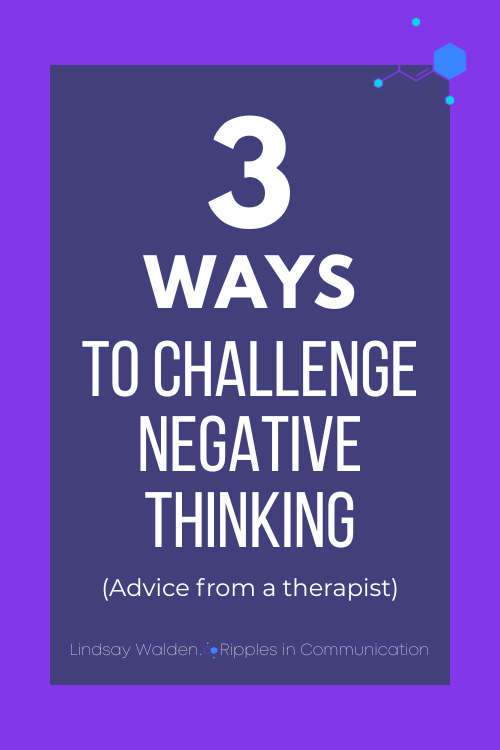How to Break Free from Negative Thinking (and Rewire Your Brain for Good)
Have you ever noticed how quickly your mind jumps to the worst conclusions?
Maybe it sounds like:
“I’m not good enough.”
“I always mess things up.”
“Nothing ever works out for me.”
“I should be doing better.”
If any of that feels familiar, you're definitely not alone.
These kinds of thoughts can feel automatic—like they just show up out of nowhere. And before you know it, you're deep in a spiral of self-criticism or hopelessness.
But here’s the truth: You’re not broken. And you’re not stuck like this. Your brain is just doing what it was designed to do.
Let’s unpack why—and what you can do about it.
Oh! Before you continue….
Have you grabbed your FREE CNT Toolkit Sampler yet? It’s packed with science-backed tools designed to help you regulate emotions, manage stress, and develop deep self-awareness. If you’ve ever felt overwhelmed by your reactions or stuck in negative thought patterns, this toolkit will give you the proven strategies I use with clients to help them strengthen emotional neutrality, rewire unhelpful responses, and build lasting resilience. Inside, you’ll find practical exercises and guided reflections to help you navigate challenges with clarity and confidence. Enter your email below, and I’ll send it straight to your inbox!
Why Negative Thinking Is Hardwired Into Your Brain
Your brain's #1 job is to protect you. And while we usually think of “danger” as physical threats, your brain also works hard to protect you from emotional pain—like rejection, failure, or shame.
That protective mechanism is why you might:
Overthink a conversation from days ago
Assume the worst in a situation before you have all the facts
Beat yourself up for making a small mistake
When something feels uncertain or risky—even if it's just emotionally risky—your brain kicks into survival mode.
And here’s where it gets even more interesting (and frustrating): The more you think a certain type of thought, the easier it becomes for your brain to keep thinking it.
Over time, negative thoughts actually carve neural pathways in your brain—like deep grooves on a well-worn path in the woods. Your brain takes that familiar trail again and again, because it’s efficient. It knows the route.
But just like a new trail can be made in the forest, new neural pathways can be created in your mind. This is where neuroplasticity comes in.
How to Rewire Negative Thinking (Using the Science of Your Brain)
Neuroplasticity is your brain’s ability to change—literally.
It means you can retrain your brain to think in healthier, more empowering ways. You can interrupt those old thought loops and create new patterns that feel better, function better, and help you move forward.
And one of the most powerful ways to do that? Journaling.
Why Journaling Is So Effective (According to Neuroscience)
Your thoughts move fast. They swirl, stack, and sometimes hit like a tidal wave. But when you write them down, something powerful happens.
Journaling helps you:
✔️ Slow your thoughts down so you can actually see them
✔️ Interrupt negative spirals before they deepen
✔️ Create distance between you and your inner critic
✔️ Reinforce new thought patterns by making them more “real” to your brain
Your brain treats written words as more concrete than passing thoughts. That’s why journaling doesn’t just feel helpful—it literally rewires your neural pathways over time.
3 Powerful Journaling Methods to Rewire Negative Thinking
You don’t need hours a day or fancy writing skills. All you need is a notebook, a few minutes, and a willingness to get curious about what’s really going on in your mind.
Here are three therapist-approved journaling tools you can start using today:
1. The Thought Reframe Method
Best for: When you catch yourself in a repetitive negative loop and want to shift your perspective.
How to do it:
Write down the negative thought exactly as it is. Example: “I always fail at everything.”
Ask yourself:
Is this always true?
What’s the evidence for and against this belief?
When have I succeeded before?
Reframe it into a more balanced truth. Example: “I don’t always fail. I’ve overcome so much. I’m learning, and that’s progress.”
Why it works: You’re training your brain to look for a more complete picture. Over time, this process strengthens healthier thinking pathways and weakens the old ones.
2. The “Talk to Your Inner Critic” Method
Best for: When your thoughts feel like they’re attacking you.
How to do it:
Write down the harsh thought as if it’s a voice speaking to you. Example: “You’re not good enough. You’ll never get this right.”
Respond to it like you’re defending your best friend. Example: “That’s not true. I’ve done hard things before, and I’ll figure this out too.”
Keep writing back and forth until you feel a shift.
Why it works: This exercise separates you from your inner critic. And once you do that, you can stop identifying with those harsh thoughts and start reclaiming your power.
3. The Gratitude Shift Method
Best for: Rebalancing a negative mood or day by shifting your focus.
How to do it:
Write one negative thought or feeling from the day. Example: “I didn’t do anything right today.”
Write down three small wins or good things that contradict it. Example: “I made someone laugh. I answered that tough email. I showed up even when it was hard.”
End with a compassionate statement to yourself. Example: “It’s okay to have tough days. I’m still growing.”
Why it works: Your brain naturally looks for danger—it’s called the “negativity bias.” But this practice teaches your mind to notice the good, which rewires your default perspective over time.
Try This Now: The “Catch & Challenge” Mini-Exercise
Want a quick way to start rewiring your brain today?
Try this:
Write down one negative thought you’ve had recently.
Challenge it with facts or a different perspective.
Reframe it into a new, empowering statement.
Example:
Negative Thought: “I’m never going to be successful.”
Challenge: “Every successful person had to start somewhere. Progress takes time.”
Reframe: “I’m building my success one step at a time.”
Even this simple exercise activates new neural circuits. And the more you do it, the stronger those new connections become.
How the Anytime Journal Helps You Rewire in Real Time
Most journals focus on reflection. The Anytime Journal goes a step further.
It’s designed as a real-time mindset tool—something you can reach for the moment your thoughts start spiraling.
With guided prompts rooted in neuroscience, the Anytime Journal helps you:
✔️ Handle self-doubt as it happens
✔️ Interrupt thought spirals quickly and effectively
✔️ Build new mental habits that actually last
It’s like having a therapist-approved mindset reset button—right at your fingertips.
So instead of stewing in stress or looping through old stories, you’ll have a way to shift gears and move forward—anytime you need it.
Final Thoughts: You Are Not Your Thoughts
Most people stay stuck in negative thinking because they:
Believe their thoughts are facts
Let one hard moment snowball into self-criticism
Don’t realize they can question their thoughts
But here’s the truth:
You are not your thoughts.
Thoughts are just stories your brain tells based on old patterns, survival instincts, and past experiences.
When you start asking, “Is this actually true?” or “What else could be true?”—you start building new stories. Better ones. More honest ones. Ones that help you heal.
So the next time your mind says, “I’m not enough,” or “I’ll never change,” pause and ask:
“Is this just a thought, or is this the truth?”
That one question could be the start of a completely different life.
Ready to take your next step? Grab your Anytime Journal and start rewiring your brain—one page at a time.








